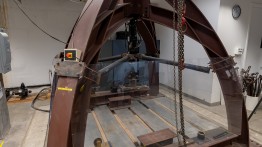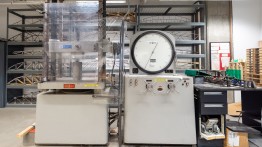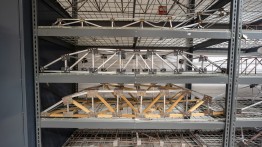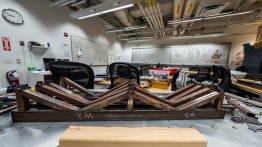Materials & Structures
This facility is maintained to meet the program’s laboratory needs in solid mechanics, properties of engineering materials, structural engineering, study of dynamic response, and concrete technology. Professor Cosmas Tzavelis is responsible for the development, direction, and operation of this laboratory. This laboratory is used in CE 121 and CE 361. The laboratory is also used in CE 369, and by master’s students for their research. The 2,400 sq. ft. facility has the following capability:
This laboratory houses the MTS 810 System that is capable of performing a wide variety of standard materials tests. The system consists of the following major components: load frame and actuator with a maximum capacity of 100 KN or 22,000 lbs., hydraulic power supply, microconsole (command post), microprofiler (programming post), A/D Boards, computer/printer and software, oscilloscope and accessories (e.g., grips, extensometers, etc.). The newly acquired MTS 793 Control software is available to perform tension tests, compression tests and low and high cycle fatigue tests.
Linear and rotary actuators that operate in conjunction with MTS 810 system but they provide additional flexibility in several areas. For example, the linear actuator permits a larger test bed for full-scale or proportional structural applications. In addition, the linear actuator has swivel capability, so that it can be positioned for horizontal, inclined or vertical load applications. The rotary actuator permits application of programmable dynamic loads to a specimen in torsion.
A universal testing machine with capacity of 120,000lb is available for a full range of tension, compression, bending, and buckling tests.
Students can use a complete range of strain gage instrumentation for the measurement and analysis of strain and stress in scale models or full-scale structures.
A vibration table for the dynamic excitation of beams or framed skeletal structural models is available for student use. Capabilities include the determination of amplitude and frequency and some vibration control.
A large test bed for heavy loading of structural systems and hydraulic loading frames are available for structural testing.
There is also a separate 400 sqft concrete mixing and casting room and another separate humidity and temperature controlled curing room for concrete.
A complete list of equipment in this laboratory, and other laboratories, is given in Appendix C.
The following acquisitions were made in this laboratory in the last 3 years:
- MTS Flex Test Model 40 Controller Hardware. It provides real-time closed- loop control, with transducer conditioning and function generation to drive our existing servo-actuators.
- MTS Series 793 Control Software. A test design application that allows you to create monotonic and cyclic tests and to acquire data.
- A computer workstation that runs MTS controller applications.








